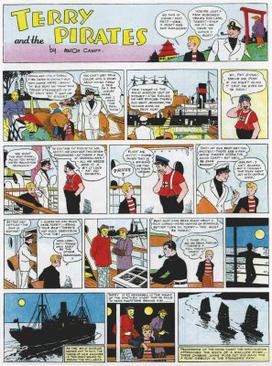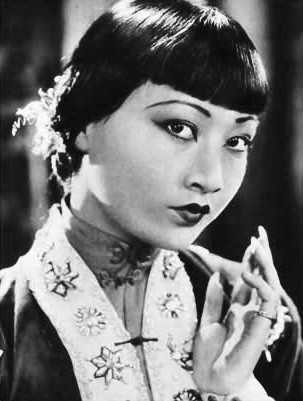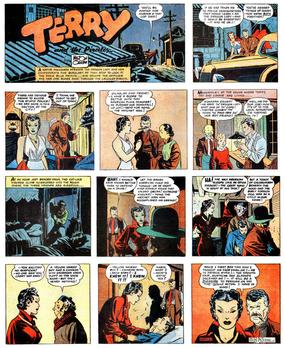
Terry and the Pirates is an action-adventure comic strip created by cartoonist Milton Caniff, which originally ran from October 22, 1934, to February 25, 1973. Captain Joseph Patterson, editor for the Chicago Tribune New York News Syndicate, had admired Caniff's work on the children's adventure strip Dickie Dare and hired him to create the new adventure strip, providing Caniff with the title and locale. The Dragon Lady leads the evil pirates; conflict with the pirates was diminished in priority when World War II started.
Terry and the Pirates is a radio serial adapted from the comic strip of the same name created in 1934 by Milton Caniff. With storylines of action, high adventure and foreign intrigue, the popular radio series enthralled listeners from 1937 through 1948. With scripts by Albert Barker, George Lowther and others, the program's directors included Cyril Armbrister, Wylie Adams, and Marty Andrews.

Terry and the Pirates is an American adventure series based on Milton Caniff's comic strip that was telecast from June 26 to November 21, 1953. The syndicated series ran for 18 episodes and was produced by Don Sharpe Enterprises. Canada Dry Ginger Ale was the show's original sponsor.

Milton Arthur Paul Caniff was an American cartoonist known for the Terry and the Pirates and Steve Canyon comic strips.

Wong Liu Tsong, known professionally as Anna May Wong, was an American actress, considered the first Chinese American film star in Hollywood, as well as the first Chinese American actress to gain international recognition. Her varied career spanned silent film, sound film, television, stage, and radio.

Steve Canyon is an American adventure comic strip by writer-artist Milton Caniff. Launched shortly after Caniff retired from his previous strip, Terry and the Pirates, Steve Canyon ran from January 13, 1947, until June 4, 1988. It ended shortly after Caniff's death. Caniff won the Reuben Award for the strip in 1971.
Dragon Lady is a stereotype of certain East Asian and occasionally South Asian or Southeast Asian women as strong, deceitful, domineering, mysterious, and often sexually alluring.
Male Call is an American comic strip series created and drawn by Milton Caniff on a volunteer basis, exclusively for US military publications during World War II. The strip began January 24, 1943. Caniff continued Male Call until seven months after V-J Day, bringing it to a conclusion on March 3, 1946.

Joseph Medill Patterson was an American journalist, publisher and founder of the Daily News in New York. At the time of his death the Daily News maintained a Sunday circulation of 4.5 million copies, the largest circulation of any paper in the United States.
The Empress Dowager is a 1975 Hong Kong historical film directed by Li Han-hsiang and produced by the Shaw Brothers Studio, starring Lisa Lu as Empress Dowager Cixi.
Ethnic stereotypes in comics have evolved over time, reflecting the changing political climate.
Stereotypes of East Asians in the United States are ethnic stereotypes found in American society about first-generation immigrants and their American-born descendants and citizenry with East Asian ancestry or whose family members who recently emigrated to the United States from East Asia, as well as members of the Chinese diaspora whose family members emigrated from Southeast Asian countries. Stereotypes of East Asians, analogous to other ethnic and racial stereotypes, are often erroneously misunderstood and negatively portrayed in American mainstream media, cinema, music, television, literature, video games, internet, as well as in other forms of creative expression in American culture and society. Many of these commonly generalized stereotypes are largely correlative to those that are also found in other Anglosphere countries, such as in Australia, Canada, New Zealand, and the United Kingdom, as entertainment and mass media are often closely interlinked between them.

Dickie Dare was a comic strip syndicated by AP Newsfeatures. Launched July 31, 1933, it was the first comic strip created by Milton Caniff before he began Terry and the Pirates. The strip ended on October 12, 1957.

Ling Woo is a fictional character in the US comedy-drama Ally McBeal, portrayed by Chinese-American actress Lucy Liu. A Mandarin-speaking Chinese-American lawyer, Ling has been described as cold and ferocious.

Katharine Augusta Carl was an American portrait painter and author. She made paintings of notable and royal people in the United States, Europe and Asia. She spent nine months in China in 1903 painting a portrait of the Empress Dowager Cixi for the St. Louis Exposition. On her return to America, she published a book about her experience, titled With the Empress Dowager of China.

Aleko Axel August Eugen Lilius was an explorer, businessman, diplomat, writer, journalist, and photographer of Finnish, Swedish, and Russian extraction. He has been described as an English journalist, a Russian Finn, an American of Finnish origin, a Swedish journalist and adventurer, and an intrepid American journalist. He is the author of I Sailed with Chinese Pirates, an account of the time he spent among pirates of the South China seas.

The Dragon Lady, also known as Madam Deal, was a well-known character in the U.S. comic strip Terry and the Pirates, created by Milton Caniff, and in the movie serial, comic books, and TV series based on the comic strip. She was modelled after Lai Choi San, a real-life 20th century pirate.

Terry and the Pirates (1940) is the 10th film serial released by Columbia. It is based on the comic strip Terry and the Pirates created by Milton Caniff. In his biography, Meanwhile..., Caniff stated that he hated the serial for changing so much of his comic strip, and that "I saw the first chapter and walked out screaming".

Bruce Gentry was an aviation adventure comic strip by Ray Bailey, distributed by the Post-Hall Syndicate. It debuted March 25, 1945, and by July the strip had expanded to 35 newspapers.
Lai Choi San (meaning Mountain of Wealth) was a Chinese pirate active in the 1920s and 1930s. Her historicity, or at the very least the historicity of most of what is known of her, is disputed since the main source on her life is the 1931 report I Sailed with Pirates by Aleko Lilius, a journalist of dubious repute.















